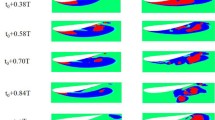Abstract
A modification to the PANS (partially averaged Navier-Stokes) model is proposed to simulate unsteady cavitating flows. In the model, the parameter f k is modified to vary as a function of the ratios between the water density and the mixture density in the local flows. The objective of this study is to validate the modified model and further understand the interaction between turbulence and cavitation around a Clark-Y hydrofoil. The comparisons between the numerical and experiment results show that the modified model can be improved to predict the cavity evolution, vortex shedding frequency and the lift force fluctuating in time fairly well, as it can effectively modulate the eddy viscosity in the cavitating region and various levels of physical turbulent fluctuations are resolved. In addition, from the computational results, it is proved that cavitation phenomenon physically influences the turbulent level, especially by the vortex shedding behaviors. Also, the mean u-velocity profiles demonstrate that the attached cavity thickness can alter the local turbulent shear layer.
Similar content being viewed by others
References
Coutier D O, Reboud J L, Delannoy Y. Numerical simulation of the unsteady behavior of cavitating flows. Int J Numer Meth Fluids, 2003, 42: 527–548
Wu J Y, Wang G Y, Shyy W. Time-dependent turbulent cavitating ow computations with interfacial transport and filter-based models. Int J Numer Meth Fluids, 2005, 49: 739–761
Delannoy Y, Kueny J L. Two-phase flow approach in unsteady cavitation modeling cavitation and multiphase flow forum. ASME-FED, 1990, 98: 153–158
Coutier D O, Fortes P R, Reboud J L. Evaluation of the turbulence model influence on the numerical simulations of unsteady cavitation. J Fluids Eng, 2003, 125(1): 38–45
Kubota A, Kato H, Yamaguchi H, et al. Unsteady structure measurement of cloud cavitation on a Foil section using conditional sampling technique. J Fluid Eng, 1989, 111(2): 204–210
Singhal A K, Vaidya N, Leonard A D. Multi-dimensional simulation of cavitating flows using a PDF model for phase change. In: ASME Fluids Engineering Division Summer Meeting. ASME Paper, 1997, FEDSM1997-3272
Merkle CL, Feng J, Buelow P E O. Computational modelling of the dynamics of sheet cavitation. In: 3rd International Symposium on Cavitation, Grenoble, France, 1998
Kunz R F, Boger D A, Stinebring D R, et al. A preconditioned Navier-Stokes method for two-phase flows with application to cavitation prediction. Comput Fluids, 2000, 29: 849–875
Senocak I, Shyy W. Interfacial dynamics-based modelling of turbulent cavitating flows, part-2: Time-dependent computations. Int J Numer Methods Fluids, 2004, 44: 997–1016
Wu J, Johansen S T, Shyy W. Filter-based unsteady RANS computations for single-phase and cavitating flows. In: ASME Heat Transfer/Fluids Engineering Summer Conference. ASME Paper, 2004, HT-FED2004-56181
Launder B E, Spalding D B. The numerical computation of turbulent flows. Comput Methods Appl Mech Eng, 1974, 3: 269–289
Spalart P. Strategies for turbulence modeling and simulations. Eng Turbulence Modelling Exp, 1999, 4: 3–17
Khorrami M R, Singer B, Berkman M E. Time accurate simulations and acoustic analysis of slat free shear layer. AIAA J, 2002, 40(7): 1284–1291
Girimaji S. Partially-averaged Navier-Stokes model for turbulence: A Reynolds-averaged Navier-Stokes to direct numerical simulation bridging method. J Appl Mech, 2006, 73: 413–421
Johansen S T, Wu J, Shyy W. Filter-based unsteady RANS computations. Int J Heat Fluid Flow, 2004, 25(1): 10–21
Kinzel M P, Lindau J W, Peltier L J, et al. Detached-eddy simulations for cavitating flows. In: 18th AIAA Computational Fluid Dynamics Conference, Miami, FL, 2007. 25–28
Ji B, Luo X W, Wu Y L, et al. Unsteady cavitating flow around a hydrofoil simulated using the partially-averaged Navier-Stokes model. Chin Phys Lett, 2012, 29(7): 076401
Huang B, Wang G Y. Partially averaged Navier-Stokes method for time-dependent turbulent cavitating flows. J Hydrodyn, 2011, 23(1): 26–33
Queipo N V, Haftka R T, Shyy W, et al. Surrogate-based analysis and optimization. Prog Aerospace Sci, 2005, 41: 1–28
Huang B, Wang G Y. Experimental and numerical investigation of unsteady cavitating flows through a 2D hydrofoil. Sci China-Tech Sci, 2011, 54(7): 1801–1812
Jeong E, Girimaji S. Partially averaged Navier Stokes model for turbulence simulations-flow past a square cylinder. J Fluids Eng, 2010, 132: 121203
Goel T, Haftka R T, Shyy W, et al. Ensemble of surrogates. J Struct Multidisc Optim, 2007, 33(3): 199–216
Goel T, Haftka R T, Queipo N V, et al. Performance estimate and simultaneous application of multiple surrogates. In: 11th AIAA/ISSMO Multidisciplinary Analysis and Optimization Conference, Portsmouth, Virginia, 2006. 6–8
Wang G Y, Senocak I, Shyy W. Dynamics of attached turbulent cavitating flows. Prog Aerospace Sci, 2001, 37(6): 551–581
Huang B, Young Y L, Wang G Y, et al. Combined experimental and computational investigation of unsteady structure of sheet/cloud cavitation. J Fluids Eng, 2013, 135: 071301
Aeschlimann V, Barre S, Djeridi H. Velocity field analysis in an experimental cavitating mixing layer. Phys Fluids, 2011, 23: 055105
Sahner J, Weinkauf T, Hege H C. Galilean invariant extraction and iconic representation of vortex core lines. Eurographics/IEEE VGTC Symposium on Visualization, UK, 2005
Kim S, Brewton S. A multiphase approach to turbulent cavitating flows. In: Proceedings of 27th Symposium on Naval Hydrodynamics, Seoul, Korea, 2008
Coutier D O. Numerical prediction of cavitation flow on a two-dimensional symmetrical hydrofoil and comparison to experiments. J Fluids Eng, 2007, 129(3): 279–291
Author information
Authors and Affiliations
Corresponding author
Rights and permissions
About this article
Cite this article
Hu, C., Wang, G., Chen, G. et al. A modified PANS model for computations of unsteady turbulence cavitating flows. Sci. China Phys. Mech. Astron. 57, 1967–1976 (2014). https://doi.org/10.1007/s11433-014-5538-6
Received:
Accepted:
Published:
Issue Date:
DOI: https://doi.org/10.1007/s11433-014-5538-6



